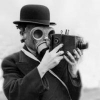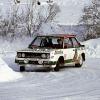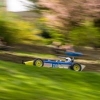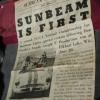
Here she is, hangared at the IWM Duxford.

The wing, engine cowlings and cockpit sides are panelled in aluminium - the fuselage aft of the cockpit and tailplane covered in traditional doped linen fabric. The stirrup and open hand hold to help pilot and ground crew clamber up onto the wing root are ingenious. They are interlinked by an internal mechanism tensioned by a bungee loop. The hand-hold hatch is normally closed
and the stirrup retracted. From ground level pull the stirrup down and the hand-hold hatch opens in sympathy. Once you're up on the wing, close the hand-hold hatch and the stirrup springs back into its fuselage stowage - clack!

This is NOT the airframe's construction plate but instead what is known as the 'Mod. plate' - modification plate, bearing relevant drawing numbers etc. It sits beneath this little perspex window on top of the starboard tailplane stabiliser. The constructor's serial number plate, I am reliably advised, is a matchbox-sized brass affair mounted within the cockpit. The Hurricane's stitched and doped fabric skin is very evident on the patch seen here, with saw-tooth cut edges to avoid fraying.

Press photo call out on the aerodrome...

Starboard side of the Packard Merlyn engine fitted...centrifugal supercharger at the rear (left). See how Hawker used mechanical joints for their multi-tubular spaceframe structures - in the engine brace - not welded joints...

Port side of the engine bay - this shot also shows the classical fabric patch fairing-in the gun ports in the wings. This aircraft is quite rare in having twelve-gun wings, the hitherto standard four machine guns being mounted inboard as here, but in this case with two more added within each wing further outboard.

This port-side access hatch gives access to the modern battery and to control-surface cable runs, as you can see.

Under-belly radiator scoop and the undercarriage stowage bay... See how there's clear view clean through the radiator matrix to the pale-coloured hangar floor beyond...

Undercarriage bay into which the oleo legs and wheels fold inwards, each leg's attached door panels then fairing-in the closed bay as they latch shut.

Here's Sidney Camm's famously preferred method of fuselage construction, inherited by the Hurricane from the preceding biplane Hawker family of Hart, Hind, Nimrod, Demon and Fury. The mechanically-jointed tube frame is given a more rounded cross-section by the bolt-on wooden formers which are then linked and braced longitudinally by add-on stringers. The red-oxide-painted linen fabric is then stretched over the combined structure, dope shrunk and painted externally... This is the view down the fuselage, from just behind the cockpit - control cables very evident... There's the stirrup/hand-hold bungee loop on the right.

The office - no cushion 'cos the pilot would sit on his parachute pack, lowered into that bucket seat. Shiny divergent panels are the heel boards for the intrepid pilot's size nines.
If anyone else is interested, I'll happily post some more. Makes a change from bloody racing cars, dunnit?
All Photos Strictly Copyright: The GP Library
DCN
Edited by Doug Nye, 01 November 2012 - 18:44.



































